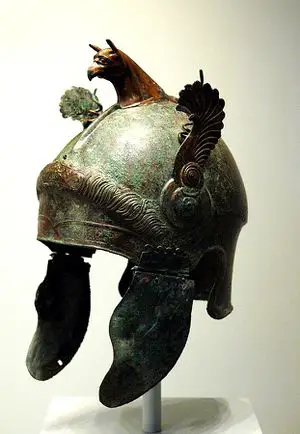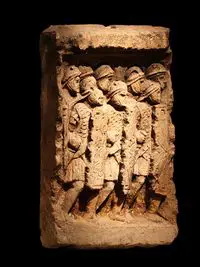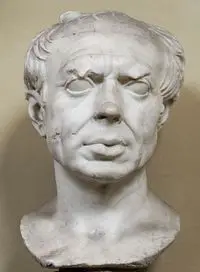How did the Social War (91-88 BCE) change the Roman Republic and Italy
The Social War or Italian War (91-88 BCE) was a conflict that pitted Rome against its Italian allies, in Latin the Socii. It was a particularly brutal war and it shook the Roman state to its foundations. The Social War immediate cause was Rome’s allies seeking their independence from the Republic. The war was to have profound consequences for Rome and especially Italy. The outcome of the Social War was that Rome remained the paramount power in Italy but that it had to make concessions to its allies. The Social War led to changes to the nature of citizenship in Rome and the Republic’s relationships to other Italian cities and communities. This in turn ultimately led to many years of stability in Italy and paved the way for the Romanization of many Italian peoples such as the Samnites.
Background
Rome’s victory in the Samnite Wars and later in the wars with Carthage meant that it was master of all Italy or Italia. The Romans did not directly rule the Italian communities but it developed a novel way of ensuring that they obeyed Rome and served her interests. Rome after defeating an Italian community offered it usually generous terms. Often these terms differed and some cities had better terms than other communities. If a city voluntary allied themselves with Rome they generally received better terms from the Republic. In theory, many of the cities and communities were independent and officially designated allies (Socii), but in fact they only had local autonomy. Italy was a collection of communities who had all some form of unequal relationship with Rome and this even applied to the Latin cities. Rome often demanded tribute and taxes from their allies and they often demand quotas of soldiers or supplies. [1] The external affairs of the communities and cities who were allied to Rome also was under the control of the Roman senate. In effect, local communities such as
Pompeii only had control over their own internal affairs and though technically allies were in reality subordinate to Rome. Despite this the Italian allies had stayed largely loyal to the Romans during the war with Hannibal, although there were exceptions such as Capua. [2] This was mainly because the local elites benefitted from the alliance with Rome. This arrangement between Rome and the Italian communities and cities worked well until the first century BC. The expansion of the great landed estates meant that many Italians were left destitute and homeless. Then Italians who served in the Roman legions did not receive as much land as Roman citizens after their service. Many Italians also wanted to participate more fully in the affairs of Rome. Above all many Italians wanted to become citizens of Rome and to avail of the great political and other advantages that that status bestowed on an individual.
The Tribune Marcus Livius Drusus in 91 BC as part of his efforts to reform the Roman Republic had wanted to grant Roman citizenship to the allies. [3] The assassination of Drusus shocked many Italians and persuaded many of them that they would never be the equals of Rome and that their interests would only be served by independence from Rome.[4] Many cities and rural communities made plans to secure their independence from Rome and they could do so because Rome was too preoccupied with civil war and political instability and this according to Plutarch fuelled the growing separatist sentiments among many of the Italian allies. [5]
Social War
In 91 BC., there was a general revolt among the Italian allies. The rebels were coordinated and many began to issue coinage proclaiming their freedom such as the Samnites. The Italian bound themselves together in a formal league, which was called Italia and it had twelve members. [6] The league had a constitution and its leaders were drawn from the main cities and tribes. The Italic League also had its own capital where representatives of the rebels would assemble. There was no central command for the Italian army. There were several armies based in local areas and cities. For example, the Samnites had their own army and operated under their own commanders in their home region. This was to prove a mistake and it later allowed the Romans to pick off the regional armies one by one. [7] Initially the Italian Confederation was very successful and Roman soldiers and colonies were driven from many areas. The Italian army was composed of men from marital societies such as the Samnites and they had fought with the Rome army. Some modern historians claim that the Italians had a combined army of over 100,000 men.
The Romans at first were not in a position to launch a counter-attack. They bided their time and attempted to divide their former Italian allies by entering secret negotiations. Rome also managed to order back some Roman legions from abroad and also received some help from its client kingdoms. [8] The two Roman Consuls led to separate armies in the north and south of Italy. The consuls were not successful and they needed the support of Sulla and Marius to prevent a total Italian victory. After a series of brutal sieges and battles, the tide began to turn in favor of Rome in 89 BCE. The Roman after a siege captured the fortress of Aesernia and this cut communications between the rebels in the south and the north. Sulla and his legions were particularly successful in the south of Italy. In the north, the Consul Strabo managed to defeat a large Italian army near Asculum and Sulla inflicted a heavy defeat on the most powerful of the Italians, the Samnites. The Roman general then entered Campania and many cities surrendered to him.[9] By 88 BC all the Italians had been defeated apart from the Samnites who held out in the mountains of central and south Italy. They only agreed to surrender after some concessions were made and indeed they were practically beyond the control of the Roman government for several years.[10]

Roman concessions to the Allies
The Romans were divided on the issue of how to treat the defeated Italians. They had been shocked by the scale of the revolt and only the Latins, had not risen. It was clear that the relationship between Rome and its allies had to change.[11] The popular party (populares) wanted to compromise and offer the Italians more rights. They had always been sympathetic to the various peoples of Italy, including the Etruscans and Lucanians. The Consul who was related to the family of Caesar. The Consul’s laws offered full citizenship to all Latin and Italian communities who had not revolted. This law was widespread and it offered citizenship to entire groups and communities. The same law also provided the citizenship to all of those who had served in the Roman army with distinction. This law was historic as it basically liberalized the system for the awarding of the Roman citizenship. A later law also extended the right to the citizenship of any man in a Roman allied state.
This effectively entitled even suitably qualified former enemies of Rome to become citizens not long after they had rebelled against the Republic. This meant also that the old system of government in Italy was no longer in place. [12] Towns that had formerly had only Latin or Allied status were now suddenly Roman municipalities. There inhabitants of many Italian communities were now citizens of their own hometowns and Roman citizens. The allies of Rome had not been able to achieve independence but they had achieved much. They were no longer the dependents and subordinates of Rome they were now increasingly the equal of the Romans. [13] In the decades that followed the provincial elites could participate in Roman political life and they became an increasingly powerful group, both locally and nationally in the Augustan age. By that time, it was not uncommon for members of local Italian elites to be elected to the Roman magistracies. [14] Many historians consider that the extension of the citizenship did much to reconcile the Italians to Roman role and indeed they became stakeholders in the Roman Republic. The provincial elites, proved to be loyal to Rome for centuries to come and served the Empire, both as soldiers and administrators.
Social and Economic impact of the wars
The wars devastated large areas of Italy and the loss of life was substantial. The historian Florus believed that the Social War was the worse in Italian history ‘’neither the devastation brought about by Hannibal nor by Pyrrhus was more serious’’. [15] During the war the small farmers suffered most and many were forced off the land. In the aftermath of the war, banditry became very common and demobilized soldiers terrorized local communities. In 78 BCE, there was a revolt among the rural poor who threatened to march on Rome. [16] The local elites often turned their villas into fortresses. At this time, many Italian farmers had to migrate to Rome and elsewhere.
By contrast the local Italian elites did very well [17]. They were the only ones who could benefit from the new rights conceded to the Italian communities as only they could meet the property qualifications required a citizen. They also could expand their estates at the expense of the many small farmers ruined by the Social Wars and indeed the other Civil Wars. The local elites in many cases were absentee landlords who lived in towns such as Pompeii, Capua or even Rome. This helped to boost urbanisation in many regions of Italy. The elite often spend lavishly in urban centres and the aftermath of the Social Wars witnessed many amphitheatres, theatres and temples built in towns such as Pompeii.[18]. The Italian regions generally were able to develop significantly in the decades after the Social War, even though the wealth was unevenly distributed.
Romanization
One of the consequences of the Social War was the increasing Romanization of the Italian regions. Prior to the First Century AD there had been many distinct cultures in Italy even though they were allied to Rome. It seems that in the aftermath of the Social War that this changed. Many ancient cultures such as the Etruscans suffered greatly during the war and the subsequent civil wars between Sulla and Marius. So much so that the Etruscan language went into sharp decline by about 50BCE. This was a pattern repeated in many regions but unlike the Etruscans, many local cultures continued to retain something of their identity. Increasingly, the local elites be they Samnite or Oscan began to identify with Rome and its culture. This led to the increasing Romanization of the elite and especially urban areas in Italy.[19] Pompeii originally an Oscan town was by the First Century AD almost identical to every other Roman municipality with its forum and amphitheatre. It must be noted that regional cultures and identities continued to flourish in some rural areas.
Conclusion
The Social War was one of the most brutal of the many internal conflicts and wars that occurred during the decline and fall of the Roman Republic. It was a war that the Romans won in the sense that they defeated the Italians bid for independence and in this way the Republic could maintain its hold on its Italian allies and dependents. Nevertheless, Rome was shaken by the Social War and it adopted a conciliatory policy towards the Italians. The Republic changed the relationship between Rome and its allies. They were after the war able to avail of the citizenship and their communities became Roman municipalities. The political organization was changed and the Italians were now legally the equals of the Romans. The chief beneficiaries of this development were the local elites who prospered after the war, while the small farmers and worker became increasingly destitute. The local elite increasingly began to identify with Roman culture and this facilitated the process of Romanization throughout much of Italy. The Social War, although it caused great devastation ultimately helped to strengthen Roman power in Italy.
References
- Jump up ↑ Flower, Harriet I. Roman Republics. (Princeton, Princeton, 2008), p. 156
- Jump up ↑ Livy. Histories. IV. 67
- Jump up ↑ Plutarch. Life of Caius Gracchus. 3
- Jump up ↑ Plutarch. Life of Marius, 24
- Jump up ↑ Plutarch, Life of Marius, 24
- Jump up ↑ Holland, Tom Rubicon: the last years of the Roman Republic. (London, Doubleday, 2005), p. 123
- Jump up ↑ Scullard, H. From the Gracchi to Nero, London (London, Methuen & Co. Ltd, 1970), p. 45, 67
- Jump up ↑ Scullard, p. 78
- Jump up ↑ Plutarch. Life of Sulla. 34
- Jump up ↑ Holland, 145
- Jump up ↑ Holland, p. 157
- Jump up ↑ Holland, p 187
- Jump up ↑ Cicero. Leg. 2.5
- Jump up ↑ Cicero Leg. 2.5
- Jump up ↑ Florus, Epitome of the Roman Histories. 2.6
- Jump up ↑ Plutarch. Life of Pompey. 24. 7
- Jump up ↑ Florus, Epitome of the Roman Histories. 2.6
- Jump up ↑ Scullard, p 114
- Jump up ↑ Scullard, 145



